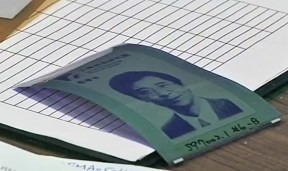A new display technology called i2R e-paper is making the rounds today. It’s developed by ITRI, a Taiwanese research company that has produced flexible AMOLED and LCD displays in the past. i2R is essentially a plastic substrate with a heat-activated liquid crystal coating: you pass it through a thermal printer and a 300dpi monochrome image is impressed on its surface — until you want to rewrite it, which you can do up to 260 times by their calculations.
Putting aside the obvious comparisons to, say, using a pencil, I’m not sure this technology is the paper-killer ITRI and some sites think it is. I have several issues with the technology:
-The display is advertised as not consuming electricity. That’s something that can be said of any bistable display — e-ink is the same way, and once made to display something, it will display it without using electricity as long as it isn’t interfered with. And i2R may not require electricity (to be specific, it has no underlying circuitry, making it a closer analog to paper), but its thermal printing device certainly does. Essentially, it requires electricity in the same way e-ink does: to change what is displayed. Presumably the crystals wear out after a time, however, limiting the rewrites.
-Heat activation limits the ways in which people can interact with these displays. The advantages of a circuit-capable substrate is the ability to include sensors such as IR or resistive touch arrays, allowing for people to write on or “click” content. Obviously the point here isn’t interactive content but reusable displays, but the gains are questionable.
-No attached memory means changing what’s on the display/paper is an involved process of feeding it through its special writer. Doing this with dozens of i2R displays doesn’t look like anything a shopkeeper would want to do.
-I’m not sure which is worse for the environment: 260 pieces of A4 being recycled, or one A4-sized piece of plastic that isn’t being recycled (I doubt the crystal coating can be removed well enough to reprocess the substrate).
-It’s glossy!
On the plus side, $2 per A4 sheet is cheap compared with other display technologies; A 6″ e-ink display costs $60 or so. Obviously you won’t be plastering your walls with Kindles. And 300dpi is enough to get some very detailed graphics or codes on there.
While I’m skeptical, I think the issue is simply that ITRI (and Reuters) are overselling it. This isn’t a wholesale replacement for paper, or e-ink for that matter: it’s a niche technology that can and should be applied in an institutional way. Think bus passes, temporary ID cards, class handouts, the sort of things that need to be rewritten semi-frequently from a central source but are mostly interacted with as static pieces of information. A “For sale!” sign isn’t the right application for this technology, and more traditional “displays” like whiteboards are also safe.
Watch Reuters’s video here. I don’t think this is the narrator’s beat, though. “It doesn’t require a backlight to print,” indeed.

